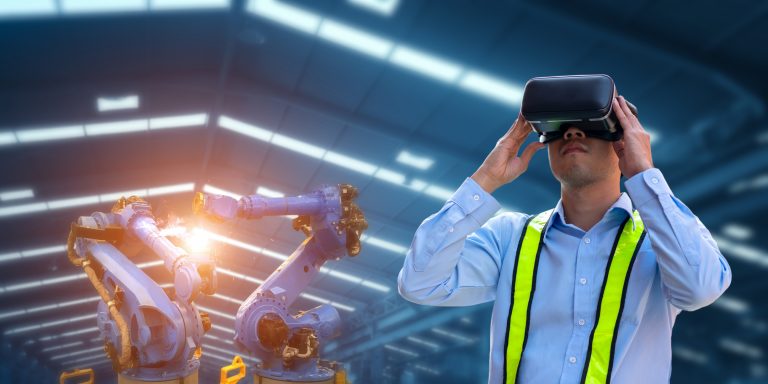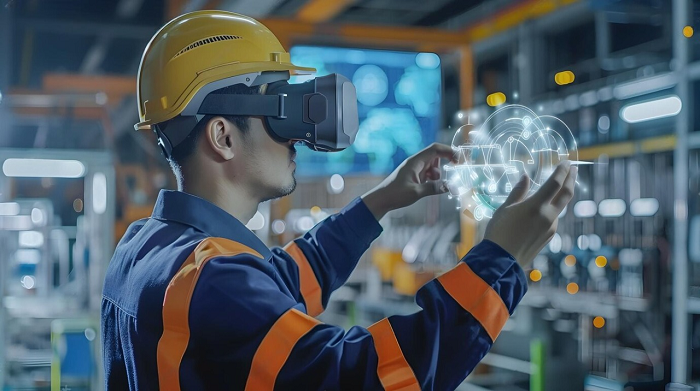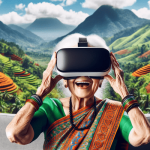VR (Virtual Reality) in industry refers to the use of immersive, computer-generated environments within various sectors for purposes such as training, design, collaboration, simulation, and visualization. It involves the integration of VR technology into industrial processes to enhance efficiency, effectiveness, and innovation across different fields.
In industrial applications, VR typically involves the use of specialized VR headsets or devices that immerse users in realistic virtual environments. These environments are created using computer-generated graphics and can simulate real-world scenarios, locations, and interactions.
Training and Simulation:
VR is used extensively for training workers in various industries, it provides a safe and controlled environment for trainees to practice skills, operate machinery, or handle complex situations without the risks associated with real-world training.
Design and Prototyping:
Industries like automotive, architecture, and product design use VR to visualize and iterate on designs. Engineers and designers can interact with 3D models in a virtual space, allowing for better understanding of spatial relationships and potential design issues.
Improved Employee Satisfaction and Retention:
Adopting VR technology can demonstrate a commitment to innovation and employee development, which can boost morale and retention rates among employees.
Increased Productivity and Efficiency:
VR streamlines processes by providing intuitive and immersive tools for tasks such as design reviews, maintenance procedures, and assembly line optimizations. This can lead to faster decision-making and improved productivity.
Remote Collaboration and Communication:
VR allows distributed teams to collaborate in virtual environments as if they were physically present together. This improves communication, fosters teamwork, and enables more effective decision-making across different locations.
Industries face a multitude of challenges and limitations that can significantly impact their operations, growth, and overall success, in the absence of Virtual Reality (VR) technology. Let us delve into some of these challenges in more detail:
Unhealth and Unsafety Concerns:
Ensuring a safe working environment for employees is a top priority for industries. Compliance with occupational health and safety standards helps mitigate risks associated with workplace accidents and illnesses.
Workforce Skills Gap:
Finding skilled workers with the right technical expertise and qualifications is a persistent challenge for industries. The rapid pace of technological advancement often outpaces the development of relevant workforce skills, leading to a skills gap that can impede growth and innovation.
High Operational Costs:
One of the foremost challenges for industries is managing high operational costs. This includes expenses related to raw materials, labour, energy consumption, and compliance with regulatory standards. Balancing these costs while maintaining profitability requires continuous optimization and efficiency improvements.
Global Competition:
In today’s interconnected world, industries face intense competition on a global scale. Keeping up with competitors, particularly those in emerging markets with lower production costs, requires constant innovation and strategic positioning.

At Kuvira, we specialize in helping businesses navigate the ever-evolving landscape of Virtual Reality (VR) industries. Our mission is to empower our clients with innovative VR solutions that leverage future trends and developments, unlocking new opportunities for growth and innovation.
Virtual Reality (VR) Integration:
Virtual Reality (VR) integration is reshaping industries by providing immersive and transformative experiences. At Kuvira, we specialize in leveraging VR technology to enhance various aspects of business operations and customer engagement.
Realistic Simulations for Design and Engineering:
In the realm of design and engineering, VR development continues to revolutionize processes. Architects, engineers, and product designers can leverage VR to visualize and interact with 3D models in real-time.
This facilitates efficient prototyping, collaborative design reviews, and detailed simulations of complex systems or structures. VR enables stakeholders to experience designs before they are built, leading to better-informed decisions and innovative solutions.
In summary, the use of Virtual Reality (VR) technology in various industries is bringing about significant improvements in efficiency, innovation, and competitiveness. VR applications offer real advantages like immersive training, better design processes, enhanced collaboration, and increased productivity. By embracing VR, businesses can tackle common challenges such as workforce skills shortages, high operational costs, and global competition more effectively.
Looking forward, the future of VR in industry looks promising with ongoing advancements in realistic simulations, remote collaboration tools, and customized VR solutions tailored to specific industry needs. Embracing these trends will be crucial for organizations aiming to stay ahead in a fast-changing market.
At Kuvira, we are dedicated to empowering businesses with innovative VR solutions that fully exploit this transformative technology. Our goal is to help clients unlock new opportunities for growth and innovation, ensuring they thrive in a dynamic VR-integrated environment. Together, we can create a future where VR drives unprecedented levels of efficiency, creativity, and success across various industries.



